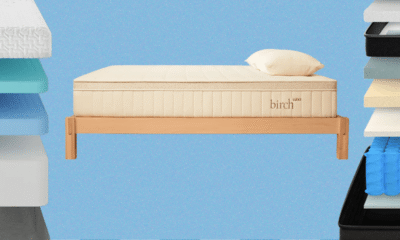Tech
The Comprehensive Guide to Babyproofing Your Home

As a new parent myself, I can tell you unequivocally that when babies become mobile, the world becomes their playground. Coffee tables become climbing gyms, cabinets become treasure troves, and phone chargers become rope toys. Babyproofing your home isn’t about bubble-wrapping your life; it’s about thinking like a young mind and getting one step ahead of curiosity. We’re here to help: This guide will help you spot hidden dangers, make smart fixes, and provide a safe space for little ones to explore without hazards around every corner.
Need a childproofing professional to help with the job? The International Association for Child Safety has a database to find one close to you.
For recommendations on our favorite baby gear, check out our guides to the Best Strollers, Best Travel Strollers, Best Baby Monitors, Best Breast Pumps, and Best Baby Carriers.
Jump to Section
Before Baby Is Born
Whether you’re expecting or your baby is still firmly in the potato stage, it’s best to start babyproofing sooner rather than later. Baby and toddler safety expert Holly Choi—whose business, Safe Beginnings, offers CPR courses, safety consultations, and more—warns that little ones often advance faster than you think. “Some kids can go from zero to 100 in a week,” she says. “They’re constantly practicing in their crib. Half the time we don’t even see it, and then suddenly, they’re in everything.” Think of babyproofing less as a weekend project and more as an ongoing lifestyle shift.
Check Smoke and Carbon Monoxide Detectors
Test/Silence button on a household carbon monoxide alarm detector.Photograph: Kenneth Cheung/Getty Images
Both smoke detectors and carbon monoxide detectors should be installed on every floor of your home, especially in or near sleeping areas. Test them monthly by pressing the built-in test button (usually in the center or on the side), and replace the batteries once a year, or right away if you hear that low-battery chirp.
The US Environmental Protection Agency estimates that 87 percent of homes built before 1940 have some lead-based paint, which can be a serious risk to children and pregnant women. The safest way to rule out lead-based paint is to hire a licensed lead inspector with your municipality’s department of health.
A safe sleep starts with the right mattress. A newborn mattress should be firm with no give, and it must fit snugly in its bassinet or crib with no gaps around the edges. (Fellow WIRED parenting writer Nena Farrell loved the one above for her son.) Stick to a fitted sheet designed for a mattress that size, and skip extra add-ons like pillows, blankets, and stuffies.
As cozy as rugs are, they can be a tripping hazard, which is the last thing you want when you’re carrying a newborn in your arms. Use nonslip pads beneath your rugs or double-sided rug tape to keep them in place, and avoid small rugs altogether in high-traffic areas. Also clear the premises of other obstacles like loose toys or cords that could catch your foot mid-step, especially on the stairs. “One in four babies injured on the stairs were being carried by an adult,” Choi says.
Introducing a baby into a home where pets rule can be stressful for everyone involved, so establishing routines with them early will help make things smoother for the whole family. Before Baby arrives, work on basic obedience with your pets. Teach dogs to sit and stay, and make sure they know the off-limit areas in the house. Help cats get comfortable with baby gates and closed doors.
First aid, CPR training with an infant mannequinPhotograph: Virojt Changyencham/Getty Images
Not a traditional babyproofing checklist item, per se, but unthinkable accidents happen no matter how prepped your home may be. Check your local hospital or the Red Cross for courses (they even offer them online) to prep you before baby arrives.
How to Babyproof Your Home’s Interior
Babies are naturally curious. We’ll break down the practical steps to make your space safer.
“If you are going to do one thing, period, I want it to be anchoring your furniture,” Choi says. “Tip-over injuries are so fast, and furniture is probably the largest hazard we all have in our home. You’re really lucky if you get a second chance with tip-over injuries.”
It takes surprisingly little force to tip over even heavy pieces of furniture, and the risks are serious. Use wall anchors to secure anything in your home that could topple over, especially tall, narrow pieces and in areas where your baby is the most mobile. Mounting furniture takes minutes, and most kits come with the basic hardware you need. And don’t forget about TVs, which should be mounted to the wall or secured with anti-tip straps.
Cover Outlets and Hide Cords
Eye-level cords and outlets are particularly inviting for babies to poke and prod. Snap-in or slide-in outlet safety covers keep tiny fingers and toys blocked from danger.
Hide or secure cords from electronics like lamps and chargers—they can be pulled, chewed on, tripped over, and dangling wires can be an opportunity to pull and bring heavy electronics down with it. Cord covers, floor strips, and cable boxes are all smart ways to keep electric cords out of reach.
Stairs, kitchens, and bathrooms can be danger zones once a baby starts moving, and baby gates are your first line of defense. (WIRED reviewer Nena Farrell recommends the one above.) For the top of stairs, a hardware-mounted gate is best, because they’re sturdier and can’t be pushed loose. “If a child throws themselves against a pressure-mounted gate, they will go down the stairs with the gate,” Choi says. “And the mechanism of injury of going down the stairs with the gate versus just going down the stairs is significantly worse.”
Doorways and hallways can use pressure-mounted options. Make sure that the gates are tall enough that your baby, a future toddler, won’t be able to climb over them and that latches are secure and childproof.
Coffee tables, TV stands, and low bookshelves often have sharp edges right at a baby’s head height. Corner guards soften the impact if your little one bumps into a corner. They come in a variety of shades and styles to blend in with furniture—just be sure they’re gripped nice and tight, since babies can be surprisingly good at peeling things loose.
Keep Medications and Cleaning Supplies Out of Reach
If you have a young one, you know that they love sticking things in their mouths, and every pill and spray can look like a toy. Medications, vitamins, and cleaning supplies should be locked up high and out of sight, and ideally in cabinets with childproof latches. This rule also goes for any “natural” or herbal products, which can still be toxic in large doses.
Close up on child proof cabinet latch and knob on far rightPhotograph: tiburonstudios/Getty Images
No matter what, you’re bound to have child-level cabinets that’ll have hazardous materials in them. Installing childproof locks on cabinets helps keep little hands away from toxic cleaners, medications, and dangerous and sharp kitchen cabinets. “We’re not locking things down because we’re going to not supervise our kids,” Choi says. “We’re locking things down since we’re just buying ourselves time.”
Tech
We Just Found Out Taylor Swift Sleeps on a Coop Pillow—They’re Having a Flash Sale to Celebrate

While I’m a mattress and sleep product expert, thanks to years of hands-on experience, I’m also aware that my opinion is not the end-all, be-all for everyone. However, when a megastar is also a fan of a product you’ve reviewed, it’s a good confirmation that you’re on the right track.
Taylor Swift, as it would turn out, is also a fan of Coop Sleep Goods—which we can confirm based on this December 10 Late Show With Stephen Colbert appearance.
Coop’s got some of our favorite pillows, particularly the Original Adjustable pillow. It comes in three shapes: the Crescent, the Cut Out, and the Classic, which is a traditional rectangular shape. I love (and regularly sleep on) the Crescent, which has a gentle curve on the bottom to allow for movement while maintaining head and neck support.
Tech
Nvidia Becomes a Major Model Maker With Nemotron 3

Nvidia has made a fortune supplying chips to companies working on artificial intelligence, but today the chipmaker took a step toward becoming a more serious model maker itself by releasing a series of cutting-edge open models, along with data and tools to help engineers use them.
The move, which comes at a moment when AI companies like OpenAI, Google, and Anthropic are developing increasingly capable chips of their own, could be a hedge against these firms veering away from Nvidia’s technology over time.
Open models are already a crucial part of the AI ecosystem with many researchers and startups using them to experiment, prototype, and build. While OpenAI and Google offer small open models, they do not update them as frequently as their rivals in China. For this reason and others, open models from Chinese companies are currently much more popular, according to data from Hugging Face, a hosting platform for open source projects.
Nvidia’s new Nemotron 3 models are among the best that can be downloaded, modified, and run on one’s own hardware, according to benchmark scores shared by the company ahead of release.
“Open innovation is the foundation of AI progress,” CEO Jensen Huang said in a statement ahead of the news. “With Nemotron, we’re transforming advanced AI into an open platform that gives developers the transparency and efficiency they need to build agentic systems at scale.”
Nvidia is taking a more fully transparent approach than many of its US rivals by releasing the data used to train Nemotron—a fact that should help engineers modify the models more easily. The company is also releasing tools to help with customization and fine-tuning. This includes a new hybrid latent mixture-of-experts model architecture, which Nvidia says is especially good for building AI agents that can take actions on computers or the web. The company is also launching libraries that allow users to train agents to do things using reinforcement learning, which involves giving models simulated rewards and punishments.
Nemotron 3 models come in three sizes: Nano, which has 30 billion parameters; Super, which has 100 billion; and Ultra, which has 500 billion. A model’s parameters loosely correspond to how capable it is as well as how unwieldy it is to run. The largest models are so cumbersome that they need to run on racks of expensive hardware.
Model Foundations
Kari Ann Briski, vice president of generative AI software for enterprise at Nvidia, said open models are important to AI builders for three reasons: Builders increasingly need to customize models for particular tasks; it often helps to hand queries off to different models; and it is easier to squeeze more intelligent responses from these models after training by having them perform a kind of simulated reasoning. “We believe open source is the foundation for AI innovation, continuing to accelerate the global economy,” Briski said.
The social media giant Meta released the first advanced open models under the name Llama in February 2023. As competition has intensified, however, Meta has signaled that its future releases might not be open source.
The move is part of a larger trend in the AI industry. Over the past year, US firms have moved away from openness, becoming more secretive about their research and more reluctant to tip off their rivals about their latest engineering tricks.
Tech
This Startup Wants to Build Self-Driving Car Software—Super Fast

For the last year and a half, two hacked white Tesla Model 3 sedans each loaded with five extra cameras and one palm-sized supercomputer have quietly cruised around San Francisco. In a city and era swarming with questions about the capabilities and limits of artificial intelligence, the startup behind the modified Teslas is trying to answer what amounts to a simple question: How quickly can a company build autonomous vehicle software today?
The startup, which is making its activities public for the first time today, is called HyprLabs. Its 17-person team (just eight of them full-time) is divided between Paris and San Francisco, and the company is helmed by an autonomous vehicle company veteran, Zoox cofounder Tim Kentley-Klay, who suddenly exited the now Amazon-owned firm in 2018. Hypr has taken in relatively little funding, $5.5 million since 2022, but its ambitions are wide-ranging. Eventually, it plans to build and operate its own robots. “Think of the love child of R2-D2 and Sonic the Hedgehog,” Kentley-Klay says. “It’s going to define a new category that doesn’t currently exist.”
For now, though, the startup is announcing its software product called Hyprdrive, which it bills as a leap forward in how engineers train vehicles to pilot themselves. These sorts of leaps are all over the robotics space, thanks to advances in machine learning that promise to bring down the cost of training autonomous vehicle software, and the amount of human labor involved. This training evolution has brought new movement to a space that for years suffered through a “trough of disillusionment,” as tech builders failed to meet their own deadlines to operate robots in public spaces. Now, robotaxis pick up paying passengers in more and more cities, and automakers make newly ambitious promises about bringing self-driving to customers’ personal cars.
But using a small, agile, and cheap team to get from “driving pretty well” to “driving much more safely than a human” is its own long hurdle. “I can’t say to you, hand on heart, that this will work,” Kentley-Klay says. “But what we’ve built is a really solid signal. It just needs to be scaled up.”
Old Tech, New Tricks
HyprLabs’ software training technique is a departure from other robotics’ startups approaches to teaching their systems to drive themselves.
First, some background: For years, the big battle in autonomous vehicles seemed to be between those who used just cameras to train their software—Tesla!—and those who depended on other sensors, too—Waymo, Cruise!—including once-expensive lidar and radar. But below the surface, larger philosophical differences churned.
Camera-only adherents like Tesla wanted to save money while scheming to launch a gigantic fleet of robots; for a decade, CEO Elon Musk’s plan has been to suddenly switch all of his customers’ cars to self-driving ones with the push of a software update. The upside was that these companies had lots and lots of data, as their not-yet self-driving cars collected images wherever they drove. This information got fed into what’s called an “end-to-end” machine learning model through reinforcement. The system takes in images—a bike—and spits out driving commands—move the steering wheel to the left and go easy on the acceleration to avoid hitting it. “It’s like training a dog,” says Philip Koopman, an autonomous vehicle software and safety researcher at Carnegie Mellon University. “At the end, you say, ‘Bad dog,” or ‘Good dog.’”
-

 Politics1 week ago
Politics1 week agoThailand launches air strikes against Cambodian military: army
-

 Fashion1 week ago
Fashion1 week agoGermany’s LuxExperience appoints Francis Belin as new CEO of Mytheresa
-

 Politics1 week ago
Politics1 week agoZelenskiy says Ukraine’s peace talks with US constructive but not easy
-

 Politics5 days ago
Politics5 days agoTrump launches gold card programme for expedited visas with a $1m price tag
-

 Tech6 days ago
Tech6 days agoJennifer Lewis ScD ’91: “Can we make tissues that are made from you, for you?”
-

 Politics1 week ago
Politics1 week ago17 found dead in migrant vessel off Crete: coastguard
-

 Business5 days ago
Business5 days agoRivian turns to AI, autonomy to woo investors as EV sales stall
-

 Entertainment1 week ago
Entertainment1 week agoToo big to fail? IndiGo crisis exposes risks in Indian aviation






















